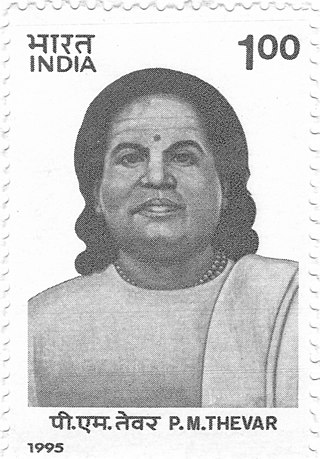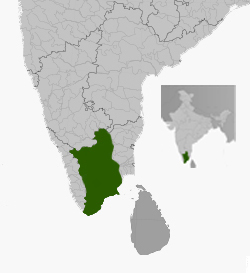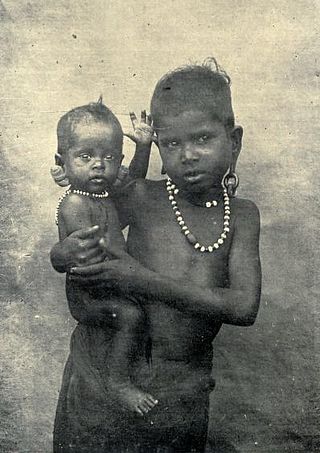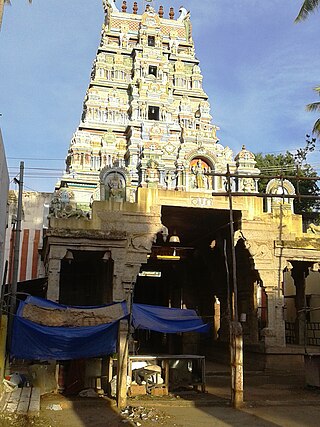
Madurai is a major city in the Indian state of Tamil Nadu. It is the cultural capital of Tamil Nadu and the administrative headquarters of Madurai District. As of the 2011 census, it was the third largest urban agglomeration in Tamil Nadu after Chennai and Coimbatore and the 33rd most populated city in India. Located on the banks of River Vaigai, Madurai has been a major settlement for two millennia and has a documented history of more than 2500 years. It is often referred to as "Thoonga Nagaram", meaning "the city that never sleeps".

The Madras Regiment is the oldest infantry regiment of the Indian Army, originating in the 1750s as a unit of the British East India Company. The regiment took part in numerous campaigns with the British Indian Army and the post-independence Indian Army.

Ukkirapandi Muthuramalinga Thevar, also known as Pasumpon Muthuramalinga Thevar, was a politician, patriarch of Thevar community. He was elected three times to the national Parliamentary Constituency. The birth anniversary of Muthuramalinga Thevar on October 30 is celebrated annually by the Thevar community in the southern districts of Tamil Nadu as Thevar Jayanthi.

Muhammad Yusuf Khan was a commandant of the British East India Company's Madras Army. He was born in a Tamil Vellalar clan family in a village called Panaiyur in British India, what is now in Nainarkoil Taluk, Ramanathapuram District of Tamil Nadu, India. He converted to Islam and was named Muhammad Yusuf Khan. He was popularly known as Khan Sahib when he became a ruler of Madurai. He became a warrior in the Arcot troops, and later a commandant for the British East India Company troops. The British and the Arcot Nawab employed him to suppress the Polygar uprising in South India. Later he was entrusted to administer the Madurai country when the Madurai Nayak rule ended.
Sholavandan is a panchayat town in Madurai district in the Indian state of Tamil Nadu. It is located on the left bank of the Vaigai River, sixteen miles north west of Madurai. It is one of 12 "town- panchayats" of Madurai district.

A valari is a traditional weapon, primarily used by the Tamil people of the Indian subcontinent. The valari resembles, and is used similar to a boomerang or throwing club. It has been used by the Tamil people in ancient battles, for protecting cattle from predators, and for hunting.The English called Valari "COLLERY" because of the name of the Kallars.

Vellore Fort is a large 16th-century fort situated in heart of the Vellore city, in the state of Tamil Nadu, India built by the Emperors of Vijayanagara. The fort was at one time the imperial capital of the Aravidu Dynasty of the Vijayanagara Empire. The fort is known for its grand ramparts, wide moat and robust masonry.

The Madurai Nayaks were a Telugu dynasty who ruled most of modern-day Tamil Nadu, India, with Madurai as their capital. The Madurai Nayaks had their origins in the Balija warrior clans of present-day Andhra Pradesh. The Nayak reign which lasted for over two centuries from around 1529 to 1736 was noted for its achievements in arts, cultural and administrative reforms, revitalization of temples previously ransacked by the Delhi Sultans, and the inauguration of a unique architectural style.

Palaiyakkarars, or Poligar, Palegara in Andhra, Karnataka and Tamil Nadu refers to the holder of a small kingdom as a feudatory to a greater sovereign. Under this system, palayam was given for valuable military services rendered by any individual. The word pālayam means domain, a military camp, or a small kingdom. This type of Palayakkarars system was in practice during the rule of Pratapa Rudhra of Warangal in the Kakatiya kingdom. The system was put in place in Tamil Nadu by Viswanatha Nayak, when he became the Nayak ruler of Madurai in 1529, with the support of his minister Ariyanathar. Traditionally there were supposed to be 72 Palayakkarars. The majority of those Palaiyakkarar, who during the late 17th- and 18th-centuries controlled much of the Telugu region as well as the Tamil area, had themselves come from the Kallar, Maravar and Vatuka communities.

The Thanjavur Maratha kingdom ruled by the Bhonsle dynasty was a principality of Tamil Nadu between the 17th and 19th centuries. Their native language was Thanjavur Marathi. Venkoji was the founder of the dynasty.

Kallar is one of the three related castes of southern India which constitute the Mukkulathor confederacy. The Kallar, along with the Maravar and Agamudayar, constitute a united social caste on the basis of parallel professions, though their locations and heritages are wholly separate from one another.

The Thirumohoor Kalamegaperumal Temple is a Hindu temple near Melur, Madurai district in the South Indian state of Tamil Nadu, is dedicated to the Hindu god Vishnu. Constructed in the Dravidian style of architecture, the temple is glorified in the Nalayira Divya Prabandham, the early medieval Tamil canon of the Alvar saints from the 6th–9th centuries CE. It is one of the 108 Divya Desams dedicated to Vishnu, who is worshipped as Kalamega Perumal and his consort Lakshmi as Mohanavalli Thayar. As per Hindu legend, the presiding deity is believed to have appeared as the divine enchantress Mohini to allure the asuras to support the devas, the celestial deities. The temple is also known as Mohanapuram and Mohanakshetram.

A. Vaidyanatha Iyer, also known as Madurai Vaidyanatha Iyer or Ayyar was an Indian activist, politician and freedom-fighter who spearheaded the temple entry movement in Madras Presidency in 1939.
The Indian independence movement had a long history in the Tamil-speaking districts of the then Madras Presidency going back to the 18th century.

The Vellore mutiny,or Vellore Revolution, occurred on 10 July 1806 and was the first instance of a large-scale and violent mutiny by Indian sepoys against the East India Company, predating the Indian Rebellion of 1857 by half a century. The revolt, which took place in the Indian city of Vellore, lasted one full day, during which mutineers seized the Vellore Fort and killed or wounded 200 British troops. The mutiny was subdued by cavalry and artillery from Arcot. Total deaths amongst the mutineers were approximately 350; with summary executions of about 100 during the suppression of the outbreak, followed by the formal court-martial of smaller numbers.
The granite scam was a corruption scandal that occurred in Tamil Nadu, India. It gained notoriety after former civil servant of Madurai Ubagarampillai Sagayam wrote a letter to the chief secretary of the State Industries Department on 19 May 2012, reporting major violations by many granite quarries in the Madurai district, estimating a loss of more than sixteen thousand crore rupees to the state exchequer.
Vellalur Nadu is a Tamil cultural village located in Melur Taluk in Madurai District in the Indian state of Tamil Nadu. Vellalur is 8.3 km from Melur, the Taluk main town; 32.1 km from Madurai East, the district's main city; 395 km from Chennai, the state's main city; and 18 km from Sivagangai. Sub-villages in Vellalur include Kattasolaipatti, Mandramalaipatti, Melavalasai, Vellanayagampatti, Idayavalasai, Mattangipatti and Edaiyarkovilpatti. Nearby temples include Karungal Swami, Manthakk Kovil, Karpaga Vinayakar, Vallidikaar, and Chinna Elai Kaatha Amman Temple. Periya Elai Kaatha Amman Temple is situated 5 km away. A two-week festival for Elai Kaatha Amman Temple is celebrated yearly starting on the last week of September. A government primary health center is located in the village. The center provides general medical services 24 hours-per-day and has a siddha medicine department. Sports clubs include various cricket clubs.
Perungamanallur is a village in Peraiyur taluk, Sedapatti block, Madurai district in the Indian state of Tamil Nadu and part of Usilampatti
Piramalai Kallars is a sub caste of the Kallars and thus are part of the Mukkulathor community that also includes the Maravar and Agamudayar castes. They belong to Other Backward class/Denotified class in Tamil nadu.
The 1997 Melavalavu massacre refers to the murder of a Panchayat President of the village and six other men of the Dalit community by dominant caste members in Melavalavu, Madurai on 30 June 1997. The men were hacked to death after some dominant caste members refused to accept a Panchayat president from the Dalit Community.














